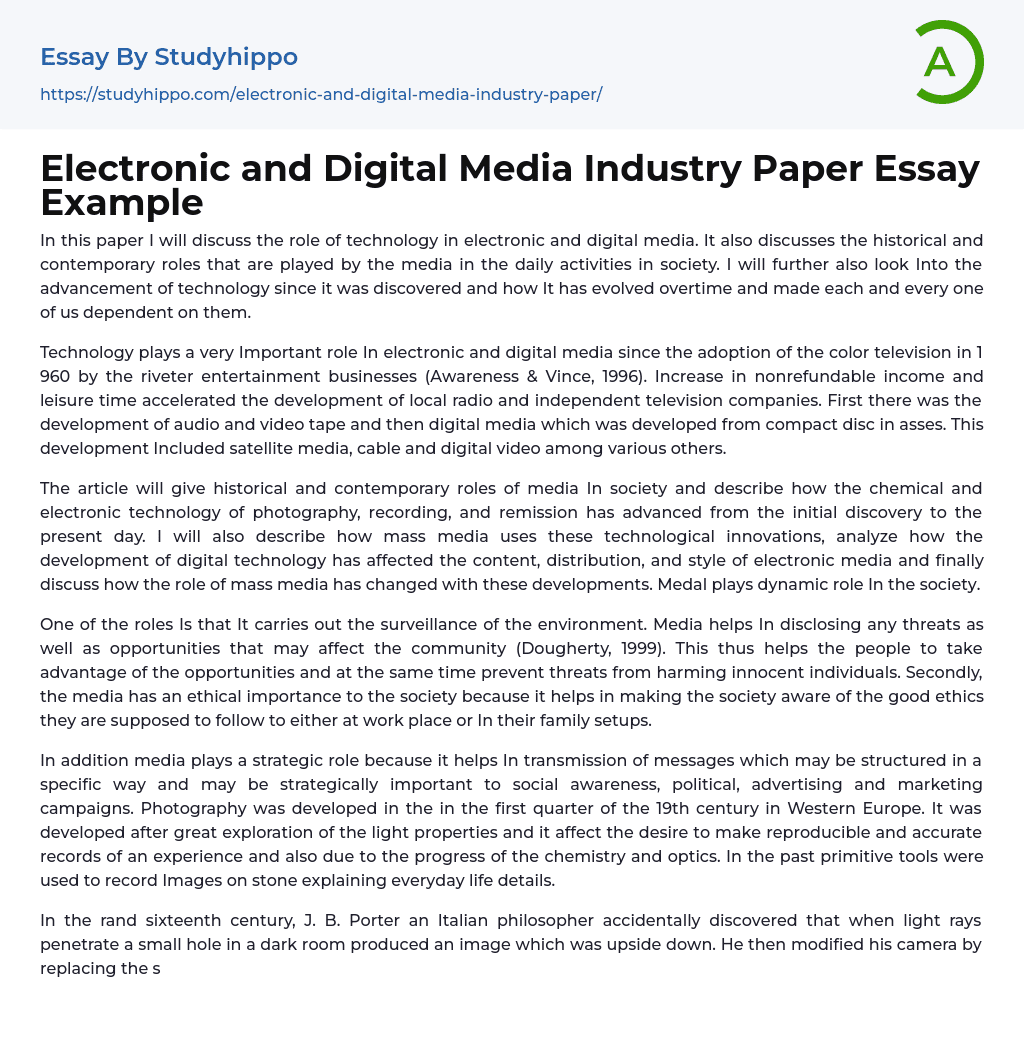

Electronic and Digital Media Industry Paper Essay Example
This paper explores the historical and contemporary significance of technology in electronic and digital media. It discusses how our dependence on technology has grown as it has evolved over time. The introduction of color television in 1960 was a major milestone that showcased the use of technology in media. With an increase in disposable income and leisure time, local radio stations and independent television companies emerged. Advancements in audio, video tape, and digital media led to the development of satellite media, cable TV, and digital video platforms. Photography, recording, and transmission technologies have also made significant progress. These innovations are effectively utilized by mass media to deliver content to audiences. The rise of digital technology has greatly impacted the content, distribution, and style of electronic media, completely transforming its role within society.
The role of media
...is multifaceted; it involves surveillance by disclosing potential threats or opportunities to individuals which allows them to take advantage while avoiding harm. Media also plays an ethical role by promoting proper ethics across various contexts. Additionally, it serves a strategic purpose by transmitting messages that hold strategic importance for social awareness campaigns politics or advertising marketing campaigns.
The origins of photography can be traced back to the early 19th century in Western Europe due to advancements in light properties chemistry opticsIn the past, images were recorded on stone using primitive tools to depict details of everyday life. It was during the late 16th century that an Italian philosopher named J.B. Porter accidentally discovered that when light rays pass through a small hole in a dark room, they create an upside-down image. Porter then replaced the small hole in his camera with
a convex lens.
Around 1835, Henry Fox Talbot found a way to create images of flowers and leaves by pressing them onto paper that had been submerged in chemicals. As time went on, photography shifted from paper to glass plates during the nineteenth century. Glass plates are still highly sought after by photographers today due to their durability over time.
In 1929, one of my colleagues developed a picture tube that improved the design of television receivers. The National Television Standards Committee applied for approval of a commercial television system in 1941, with each channel having its own specific frequency.
Sony made significant strides in video camera technology when they introduced the first one in 1982. Kodak followed suit by introducing a high-quality digital camera in 1994. The mass marketing of these digital cameras for consumers began around 1996.
Throughout history, technological advancements have played a crucial role in shaping mass media development. For instance, inventions such as the printing press enabled widespread circulation of mass newspapers while radio broadcasting benefited from various technological improvements.
The presence of computer technology has completely revolutionized the mass media industry and continues to do so today.Computers have revolutionized how information is stored and transmitted, allowing for efficient transfer of data. Digital computers have paved the way for advancements like digital recordings, satellite broadcasts, and global computer networks. By utilizing digital technology, various forms of content such as images, videos, audios, animations, and text can be easily manipulated by computers. This has led to the gradual replacement of analog communication technology with its digital counterpart.
One advantage of digital technology over analog is its capability to transmit and replicate content with utmost precision. Unlike analog
technology which often results in imperfect copies, digital technology enables flawless transmission and duplication through accurate digit copying. Consequently, digital technology plays two crucial roles within media: firstly, it provides a faultless method for transmitting media content while also recording and storing it; secondly, it serves as a means for representing media content to be used alongside computers and related technologies.
Technological progress has led to the creation of various devices dedicated to oral and written communication. These advancements ensure accuracy, speediness, as well as the ability to swiftly reload messages when needed. Visual, audiovisual,
and electronic media are now essential in communication.
The advancements in technology have not only enhanced communication through telex-lecturing and television short circuit, but also resulted in the creation of new telecommunication devices. The media industry has greatly benefitted from technological innovation by producing more efficient devices that allow for faster storage and transmission capabilities. Thanks to the progress of technology and digital media, individuals like myself can now receive an education and complete schooling despite having busy schedules due to family responsibilities or other factors. From my point of view, technology has ultimately made life more convenient, providing opportunities that were previously out of reach.
- Collaboration essays
- Dialogue essays
- Fake News essays
- Journalism essays
- Mass Media essays
- Media Analysis essays
- Media Bias essays
- Media Studies essays
- Message essays
- News essays
- Propaganda essays
- Radio essays
- Rogerian Argument essays
- Role of Media essays
- Social Media essays
- Social Media Marketing essays
- Social Networking essays
- Youtube essays
- Architecture essays
- Design essays
- Graffiti essays
- Graphic essays
- Interior design essays
- Painting essays
- Photography essays
- Sculpture essays
- Typography essays
- Network Topology essays
- Telecommunication essays
- Telecommunications essays



